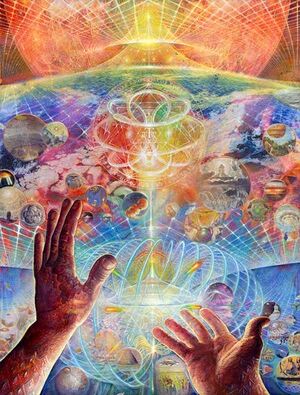Psychedelic art: Difference between revisions
>Oskykins No edit summary |
>Oskykins |
||
| Line 18: | Line 18: | ||
==See also== | ==See also== | ||
*[[Replication index]] | *[[Replication index]] | ||
*[[ | *[[Psychedelic]] | ||
*[[ | *[[Geometry]] | ||
*[[ | *[[Autonomous entities]] | ||
Revision as of 19:47, 28 March 2015

Template:Proofread Psychedelic art is any art inspired by psychedelic experiences known to follow the ingestion of psychoactive drugs such as LSD and psilocybin. The word "psychedelic" (coined by psychologist Humphry Osmond) means "mind manifesting". By that definition, all artistic efforts to depict the inner world of the psyche may be considered "psychedelic".
In common parlance "psychedelic art" refers above all to the art movement of the late 1960s counterculture. Psychedelic visual arts were a counterpart to psychedelic rock music. Concert posters, album covers, light shows, murals, comic books, underground newspapers and more reflected not only the kaleidoscopically swirling patterns of LSD hallucinations, but also revolutionary political, social and spiritual sentiments inspired by insights derived from these psychedelic states of consciousness.
Features
- Fantastic, metaphysical and surrealistic subject matter
- Depictions of geometry based autonomous entities
- Kaleidoscopic, fractal or paisley patterns
- Bright and/or highly contrasting colors
- Extreme depth of detail or stylization of detail. Also so called Horror vacui style.
- Morphing of objects and/or themes and sometimes collage
- Phosphenes, spirals, concentric circles, diffraction patterns, and other entoptic motifs
- Repetition of motifs
- Innovative typography and hand-lettering, including warping and transposition of positive and negative spaces